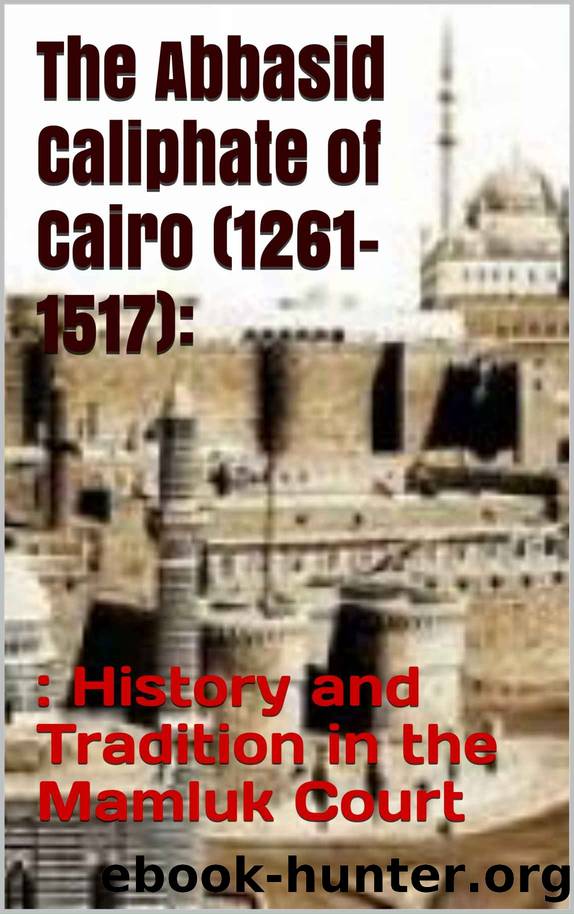The Abbasid Caliphate of Cairo (1261-1517): : : History and Tradition in the Mamluk Court by Rami Abdelaal

Author:Rami Abdelaal [Abdelaal, Rami]
Language: eng
Format: azw3
Publisher: UNKNOWN
Published: 2020-09-06T16:00:00+00:00
1502 ‘Abd al-Raḥmān ibn Khaldūn, Ta’rīkh al-‘allāma Ibn Khaldūn (Beirut: Dār al-Kitāb al-Lubnānī, 1961),
5:802. See also: Ulrich Haarmann, “Ideology and History, Identity and Alterity: The Arab Image of the Turk from the ‘Abbasids to Modern Egypt,” International Journal of Middle East Studies 20, no. 2 (1988):
182; Khalidi, Arabic Historical Thought, 228-31; Irwin, “Mamluk History and Historians,” 166.
1503Ibn Khaldūn, Ta’rīkh, 5:802. For a lengthier treatment of Ibn Khaldūn’s remarks on the Mamluk training process, see: Little, “Religion under the Mamluks,” 165-7; David Ayalon, “Mamlūkīyyat: (A) A First Attempt to Evaluate the Mamlūk Military System; (B) Ibn Khaldun’s View of the Mamlūk Phenomenon,” Jerusalem Studies in Arabic and Islam 2 (1980): 340-9; idem, “The Mamlūks and Ibn Xaldūn,” Israel Oriental Studies 10 (1980): 11-3.
1504Ibn Khaldūn, Muqaddima, 195-6.
1505 Ibid., 195. This had been the case in Syria during the age of the Israelites.
1506 Ibid., 196.
The one who usurps authority may be among the possessors of ‘aṣabiyya of the tribe that obtained kingship. He does not plan to take power and subvert kingship conspicuously, rather he merely appropriates its fruits (i.e. commanding the good and forbidding the wrong, binding and loosening, confirming and deposing), while giving the impression to the people of the [Abbasid] dynasty that he disposes affairs on their behalf, exercising the ruler’s orders from behind the curtain. He withdraws from the attributes of kingship and its symbols and royal titles in hope of avoiding suspicion, despite fully exercising control in his own right.1508
The Mamluks, unlike earlier rulers who wished to distance themselves from the caliphal figureheads under their tutelage, sought a more direct absorption of Abbasid attributes in their attempt to present their capital as the new bulwark of Islamdom. Keenly aware that the caliphate had been depreciated by his own time, Ibn Khaldūn was a careful self-censor of his remarks on the Mamluk regime. In an analysis of what happens when a leader’s control is usurped by unauthorized advisors or underlings, Ibn Khaldūn mentions Turkish, Buyid, and Seljuq domination of the Abbasid caliphs, along with the eunuch Kāfūr’s (d. 357/968) usurpation of two Ikhshīdid princes in tenth century Egypt.1509The author’s ideas on the child rulers of weakened dynasties have bearing on the later Qalawunid sultans, many of whom were adolescents subject to the whims of their fathers’ amirs.1510 To be sure, there are parallels with the Mamluk context in regard to the regime’s seizure of Abbasid prerogatives. It is unsurprising that Ibn Khaldūn avoids direct comparison with the contemporary situation of Egypt and instead praises his Mamluk patrons.
The Muqaddima avoided controversial topics in recent history, such as the Mamluk takeover from the popular Ayyubids and the rise of Barqūq and the Circassian slaves at the expense of the entrenched Baḥrī Turkish line of Qalawunid sultans supported by Mamluk custom and tradition. Addressing such topics to illustrate theories of usurpation could prove just as seditious as an unflattering interpretation of Mamluk protection of Abbasid survivors. Instead, Ibn Khaldūn downplayed the significance of the Abbasid caliphate of Cairo and presented a positive image of Mamluk deeds done solely for the sake of Islam.
Download
This site does not store any files on its server. We only index and link to content provided by other sites. Please contact the content providers to delete copyright contents if any and email us, we'll remove relevant links or contents immediately.
| Africa | Americas |
| Arctic & Antarctica | Asia |
| Australia & Oceania | Europe |
| Middle East | Russia |
| United States | World |
| Ancient Civilizations | Military |
| Historical Study & Educational Resources |
The Battle of Mogadishu by Matt Eversmann & Dan Schilling(626)
The Confidence Men by Margalit Fox(545)
The Spymaster of Baghdad by Margaret Coker(541)
A History of the Muslim World since 1260: The Making of a Global Community by Vernon O. Egger(522)
Jack the Ripper and the East End by Peter Ackroyd(482)
Empire of Fear: Inside the Islamic State by Andrew Hosken(471)
The Crimean War by Winfried Baumgart(469)
Islam At The Gates: How Christendom Defeated the Ottoman Turks by Diane Moczar(467)
The Afghanistan File by Prince Turki AlFaisal Al Saud(467)
The Jerusalem Diamond by Noah Gordon(460)
Akhenaten by Dominic Montserrat(451)
A Concise History of Greece (Cambridge Concise Histories) by Richard Clogg(448)
Israel: Ancient Kingdom or Late Invention? by Daniel I. Block(445)
Enemy in the East by Rolf-Dieter Müller(442)
The History of Jihad by Robert Spencer(440)
The Privatization of Israeli Security by Shir Hever(432)
Destroying a Nation: The Civil War in Syria by Nikolaos van Dam(430)
The Nine Lives of Pakistan by Declan WALSH(422)
The Dirty War in Kashmir by Shujaat Bukhari(409)
